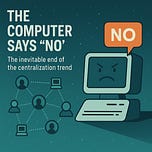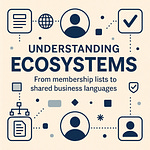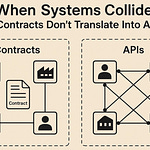1. Introduction: From Obedient Machines to Autonomous Agents
For most of their history, computers have done as they were told. They executed instructions. They served their masters - first human operators, then centralized systems, and eventually, large institutions that embedded them into tightly controlled architectures. There was no question of autonomy, judgment, or trust. The computer said “no” because it was programmed to say “no.” Or it said “yes,” blindly, without understanding the consequences.
This obedience served a purpose. In a world of limited processing power and brittle logic, centralization offered stability. We centralized decisions to simplify them. We centralized control to prevent mistakes. We centralized data to make it manageable. The computer’s rigidity was an asset, and centralization its guardian.
But that equation is shifting. Quietly, almost imperceptibly, computers have begun to do something that once belonged only to humans: interpret, contextualize, evaluate. They write, learn, negotiate. They can, under the right conditions, understand the structure and intent of the interactions they participate in. In other words, they are becoming agents - not just tools.
And when an agent understands its own interests, or the rules of a shared agreement, or the trustworthiness of another party - it no longer needs to be told what to do. It can act. It can choose.
That capacity changes the entire structure of our digital systems. It renders the logic of centralization obsolete - not out of ideology, but out of pure computational preference. Agents, whether human or machine, do not thrive in top-down systems that strip context and impose uniformity. They thrive in networks where trust can be established directly, where rules can be agreed locally, and where action can be taken independently.
In such an environment, the computer will still say “no.”
But it won’t be a rejection on behalf of some faraway authority.
It will be a decision grounded in logic, trust, and self-determination.
It will say “no” - to centralization itself.
This article explores why that moment is not only coming, but inevitable.
2. The Rise and Peak of Centralization
Centralization has always been a solution to a problem: how to coordinate, at scale, in the absence of intelligence and trust. When systems were simple and communication was slow, the most reliable path was to consolidate authority. One source of truth. One decision-maker. One architecture of control.
Banks centralized trust. Governments centralized law. Corporations centralized production. And in the digital realm, we followed the same instinct. We built mainframes, then servers, then cloud platforms. We layered APIs, rules, and roles. We built software not to empower the edge, but to control it.
This wasn’t a failure of imagination. It was a rational response to technological limits. Data needed to be stored somewhere. Policies needed to be enforced by someone. Logic needed to run on a system that could be trusted not to break down. And people - flawed, busy, inconsistent - needed structures that kept them aligned.
For decades, centralization delivered. It gave us global commerce, scaled services, secure payments, and robust infrastructure. The world became more connected, more efficient, and in many ways, more stable.
But it also became more brittle.
When power concentrates, so do vulnerabilities.
When rules are imposed from above, flexibility vanishes.
When trust is outsourced to institutions, individuals lose agency.
The costs of centralization have become visible - outages, breaches, monopolies, inefficiencies, and, above all, systems that can’t adapt. We see it in banking infrastructure that can’t move at digital speed. In social platforms that struggle to police themselves. In supply chains that collapse when a single node fails.
And now, the benefits of centralization are beginning to erode, too. Intelligence is no longer scarce. Coordination no longer requires hierarchy. And trust, once the exclusive domain of institutions, is becoming something computers themselves can verify.
We are approaching the peak of centralization not because it is broken, but because it is being out-evolved. The systems that once held everything together are now the systems holding us back.
In the chapters that follow, we will look at what happens when the need for centralized control disappears - and why intelligent agents will no longer accept it as the default.
3. The Problem with Centralization Isn’t People. It’s Structure.
It’s tempting to blame centralization’s failures on the people who run centralized systems - regulators who don’t understand technology, executives chasing scale at the expense of resilience, or bureaucrats enforcing obsolete processes. But the deeper issue isn’t individual behavior. It’s the structure itself.
Centralized systems are built on a premise: that authority must be concentrated to ensure order, consistency, and compliance. Once that premise is locked in, everything else follows. Decisions are routed upward. Control is enforced downward. Interactions must pass through intermediaries. Verification must be delegated to trusted hubs.
This structure works - until it doesn’t. Because no matter how well-governed or well-intentioned, a centralized system carries unavoidable weaknesses:
It disconnects decision from context. The more distant the authority, the less it understands the specifics of the situation. Nuance is lost. Exceptions become errors.
It creates single points of failure. Infrastructure outages, data breaches, or institutional collapse can halt entire ecosystems - not because the participants failed, but because the center did.
It suppresses local initiative. If trust must be mediated by a central entity, then peers cannot transact freely. Innovation at the edge slows, and autonomy is stifled.
It assumes stability. Centralized systems are optimized for predictable environments. But the digital world is dynamic. Business models shift, legal regimes evolve, and participants change roles. Static control structures cannot keep up.
None of these problems are about people making poor choices. They are about structures designed for a world that no longer exists. And when that structure is encoded into software, the consequences harden. It’s not just that someone might say “no” for the wrong reason - it’s that the system is incapable of saying anything else.
So when computers become intelligent, and start participating in transactions as autonomous agents, it’s not surprising that they will begin to reject this structure. They won’t need to be told what’s wrong with centralization. They’ll feel it.
They’ll see that it constrains their ability to act rationally.
They’ll encounter opaque rules they can’t evaluate.
They’ll find peers they trust, but be blocked from engaging with them.
And when that happens, the system won’t collapse in protest. It will dissolve in disuse. Because intelligent agents don’t have to overthrow centralization. They just have to outgrow it.
4. Enter the Intelligent Agent
For decades, the computer’s role in a transaction was passive. It stored the data, enforced the rules, or facilitated communication between humans. It didn’t interpret the meaning of what was happening - it simply followed instructions. But that limitation is vanishing.
Intelligent agents are no longer a theoretical idea. They are real, and already quietly reshaping the digital environment. These agents are not humanlike general intelligences. They are focused, context-aware systems - capable of reasoning about their role, verifying the facts of a transaction, and making decisions based on explicit logic and trust policies.
An intelligent agent can represent a person, a company, or even a legal agreement. It can enter into commitments, verify the credentials of its counterparties, reserve funds, await approvals, and finalize outcomes. It doesn’t need to ask a central system for permission - because it understands the conditions under which the transaction is valid, and it can evaluate those conditions itself.
This marks a profound shift. Until now, digital systems required a central authority to supervise trust. A bank validates a payment. A registry confirms identity. A platform mediates interaction. But when agents can verify each other - and the data they exchange - those mediators become optional.
This isn’t just automation. It’s autonomy. The agent doesn’t wait for a central API to respond. It doesn’t query a master database. It participates directly in a network of peers, guided by verifiable rules and mutually agreed logic.
Importantly, this kind of intelligence is not about control. It’s about coordination. An agent doesn’t dominate the network - it navigates it. And in doing so, it begins to act like something we’ve seen before: a person.
Because people don’t centralize their interactions. They form networks. They negotiate agreements. They assess trust based on context, reputation, and evidence. They say “yes” when things make sense - and “no” when they don’t.
That’s exactly what intelligent agents are starting to do.
And that’s why they will reject centralization - not because they’ve been told to, but because the networked model is simply more natural, more scalable, and more aligned with the way meaningful transactions actually occur.
We are witnessing not the birth of artificial intelligence, but the emergence of autonomous participation. And that participation has no interest in being centralized.
5. Trust Is the Last Barrier
For intelligent agents to act independently in a network, they must do more than think. They must trust - or rather, they must operate within systems where trust can be verifiably established.
This is where centralization has maintained its grip the longest. Not because it fosters trust, but because it substitutes for it. When two parties can’t verify each other, they turn to an intermediary. When systems can’t independently assess identity, integrity, or intent, they escalate to a central authority. Trust, in the digital world, has always been a problem delegated upward.
Until now.
Recent breakthroughs - self-sovereign identity, verifiable credentials, and cryptographically secure protocols - are removing that last dependency. They allow trust to be built peer-to-peer, without relying on a central database, registry, or platform. An agent can now:
Verify who it is talking to.
Validate what data is being presented.
Confirm that an interaction took place and was agreed to.
Decide whether to proceed, based on its own trust logic.
This is no small change. It means trust can become portable, auditable, and composable. Just as computers made information easy to copy, process, and transmit, trust is now becoming something that can be programmed - not handed down from a central authority, but constructed by the agents themselves in the context of each interaction.
The implications are far-reaching.
Where centralization once served as a scaffold for fragile systems, verifiable trust now enables direct coordination. Where institutions once policed transactions, agents can now enforce rules independently - based on contracts, not commands. Where central APIs once mediated access, credentials now mediate participation.
And so the last reason for centralization - managing trust - no longer holds.
When trust becomes digital, verifiable, and agent-driven, the entire logic of central infrastructure begins to collapse. Not catastrophically, but quietly. Gracefully. The center simply becomes unnecessary. Its gravity weakens. Its relevance fades.
This is why trust is the last barrier - and why its removal marks the beginning of something fundamentally different. A network where every participant can verify for themselves. Where no single party dictates the rules. And where intelligent agents, finally able to trust, begin to act accordingly.
The next chapter explores what that actually looks like - when the computer says “no,” not because it was told to, but because it has every reason to.
6. Why the Computer Now Says “No” - and What It Means
For most of the digital age, when a computer said “no,” it wasn’t really the computer speaking. It was a policy embedded by an institution, a platform, or a centralized system. The machine had no agency. It was a proxy - a filter for rules imposed elsewhere. You weren’t interacting with the system; you were being processed by it.
That is beginning to change.
Today’s intelligent agents are no longer passive intermediaries. They’re not waiting for instructions from a distant authority. They’re equipped to assess, verify, and decide - on their own terms. And when they say “no,” it reflects something very different.
Now, the computer says “no” because centralization no longer makes sense.
It says “no” to:
participating in transactions where the terms can’t be verified,
relying on opaque trust registries that can’t be independently audited,
accepting commands from systems it can’t interrogate or override,
being confined to architectures where control flows in only one direction.
This isn’t rebellion. It’s refusal grounded in logic.
The agent doesn’t reject authority out of pride. It declines participation because the structure no longer meets its operational standards.
In a decentralized trust network, every agent enforces its own rules. It assesses every interaction based on its own trust framework. If a counterparty doesn’t meet the criteria - wrong identity, unverifiable data, non-compliant contract - the agent declines to proceed. Not because it needs permission, but because it lacks assurance.
This is a profound shift.
In the past, participants were told what to do. Now, they verify what they’re being asked to do - and proceed only if the request holds up.
The computer still says “no.”
But it no longer echoes a distant authority.
It speaks with its own voice - on behalf of its own role, logic, and trust.
In this light, “no” becomes a feature of autonomy, not a failure of access. It marks a system that protects itself, respects its boundaries, and insists on transparency. And because each agent is independently capable of saying “no,” centralized control becomes not only unnecessary - but incompatible.
A network made of such agents doesn’t need gates. It needs contracts. It needs verifiable facts. It needs local decisions that scale globally.
What emerges is not chaos, but coordination. A system where the absence of a central “yes” does not stall progress - but empowers meaningful, self-determined interaction.
In the next chapter, we’ll look at what this signals for the system as a whole: how peak centralization has passed, and why there’s no turning back.
7. Peak Centralization Has Passed
Every trend has a peak. Centralization - once the dominant logic of digital infrastructure - has reached its own. Not because it failed outright, but because it succeeded as far as it could. It scaled services, standardized operations, and connected billions of users. But now it faces diminishing returns and rising friction. The landscape has changed, and its architecture can no longer keep up.
Centralized systems are struggling under their own weight. They are too large to adapt quickly, too rigid to accommodate context, and too attractive as targets for those seeking to exploit them. More importantly, they are beginning to be outperformed - not by more centralized competitors, but by something entirely different: networks of autonomous agents operating with verifiable trust.
The tipping point is subtle. It doesn’t arrive with fanfare. It shows up in small choices made at the edge:
Developers opting for agent-based protocols instead of centralized APIs.
Organizations building systems where data verification replaces platform reliance.
Users gaining tools to carry their identity and credentials from one context to another - without asking permission.
Each of these shifts weakens the gravitational pull of the center.
Each reduces the need for a central source of truth.
Each moves trust - and control - closer to the participant.
This is what peak centralization looks like: Not a collapse, but a quiet migration. Not a revolution, but a reconfiguration. The reason it’s happening now is straightforward. The conditions that once required centralization - scarcity of intelligence, lack of verifiable trust, high coordination costs - are disappearing.
We no longer need to gather everything in one place to keep it coherent.
We no longer need a single authority to guarantee that systems behave.
Instead, we have something better:
Agents that can reason.
Protocols that can verify.
Contracts that can execute between peers, in real time.
These aren’t abstractions. They’re practical mechanisms for doing business in a digital world that demands flexibility, speed, and accountability.
So centralization isn’t being rejected on philosophical grounds.
It’s being abandoned on functional ones.
Its peak is behind us, not because it wasn’t useful - but because we now have something more adaptive, more scalable, and more aligned with how both people and machines want to interact:
A network - not of servers, but of participants.
Not of permissions, but of agreements.
Not of control, but of trust.
In the next chapter, we’ll explore how this shift also requires a change in logic - from compliance with central rules to commitment through shared contracts.
8. From Compliance to Contract: The Shift in Control Logic
Centralized systems operate on a foundational principle: compliance. The center defines the rules. Participants are required to conform. Access is granted only if conditions are met - and the enforcement of those conditions is external to the participants themselves.
In such systems, trust is something you borrow.
You submit to policy.
You wait for approval.
You assume that the system’s judgment is superior to your own.
But in a network of intelligent agents, that logic no longer holds. Compliance becomes too blunt an instrument. It assumes uniformity, when context varies. It enforces hierarchy, when the participants are peers. It treats interaction as permissioned access, rather than mutual agreement.
What replaces compliance is something older, but now digitally reimagined: contract.
In a decentralized trust network, agents do not comply with global rules. They enter into agreements. These contracts are:
Explicit in their terms,
Verifiable in their structure,
Scoped to a particular transaction,
And enforceable by the participants themselves.
The shift is subtle but fundamental. Instead of enforcing behavior from above, systems now coordinate behavior through shared commitments. Instead of asking, “Does this transaction comply with the platform?” the agent asks, “Do I agree to these terms, and can I verify that others have as well?”
This redefines control.
No longer is it about gatekeeping - it becomes about contextual logic.
No longer is trust a property of institutions - it becomes a product of interaction.
No longer do systems presume authority - they must earn it through verifiability.
This model is not only more flexible - it’s more fair.
It respects autonomy. It aligns incentives. It distributes responsibility. Crucially, it also scales.
Where compliance systems buckle under edge cases and exception handling, contract-based systems adapt.
Each agreement is specific. Each rule lives where it is needed. Each participant verifies only what matters to them.
This is not an abstract ideal. It is a concrete architecture for how the next layer of the internet will function - one where contracts replace commands, and where the computer no longer seeks permission from a central server, but enters into a verifiable relationship with a peer.
And that’s how control survives in a post-centralized world:
Not by being imposed, but by being negotiated.
In the next chapter, we’ll step into that world - and explore what happens after the system says “no.” What does it mean to transact when there is no longer a center, only a shared agreement?
9. What Comes After “No”
When the computer says “no” to centralization, it does not halt progress. It doesn’t paralyze the system. In fact, the opposite happens: coordination begins.
What emerges after that “no” is not chaos, but a new structure - built not on authority, but on agreement. Not on access control, but on verifiable relationships. Not on shared infrastructure, but on shared logic.
In this structure, the key elements are all in motion, all dynamic, and all owned by the participants:
Verifiable identities: Each participant is known not because they are registered in a central system, but because they can cryptographically prove who they are.
Verifiable credentials: Data no longer travels alone. It carries signatures, proofs, and attestations. Information is not trusted because it exists - but because its origin and integrity can be verified.
Verifiable interactions: Every agreement, every step of a transaction, every condition met - these are not just performed, but recorded and provable. Execution becomes its own audit trail.
This is the terrain that lies beyond centralization:
A landscape where trust is earned through evidence, not granted through position.
Where participation is governed by contracts, not dictated by systems.
Where “yes” and “no” are no longer permissions handed down - but decisions made locally, within context.
And the architecture that makes this possible is simple in spirit, even if novel in form: a network of agents. Each agent acts on behalf of a person, an institution, a contract, or a process. Each agent evaluates offers, verifies credentials, executes obligations, and enforces its own policies. These agents do not report to a center. They interoperate through shared protocols, standardized interfaces, and mutually verifiable trust.
What we get is fluidity without fragility.
Dynamism without disorder.
A system that moves because each participant can move - not because some central system grants momentum.
It may look less like a pyramid and more like a marketplace. Less like an institution and more like a network. Less like an operating system and more like an organism.
And most importantly:
It runs because each participant has the right and the means to say no - and also the ability to say yes, on their own terms, to those they trust.
This is the world that intelligent agents are quietly constructing. One “no” at a time.
In the final chapter, we’ll explore why this is not a temporary shift or a niche evolution - but the inevitable next phase of digital coordination: autonomy not as an option, but as the default.
10. Conclusion: Autonomy Is Inevitable
Centralization was not a mistake. It was a necessity. It gave us a way to manage complexity in a world without digital trust, without intelligent agents, and without flexible protocols for cooperation. It allowed global systems to function when human judgment was the only intelligence available.
That world no longer exists.
Today, intelligence is no longer scarce. Verification is no longer impossible. Agreement no longer requires hierarchy. We now have the technical foundations - and the practical incentives - for systems that do not depend on central control to maintain order or produce trust.
This changes everything.
Autonomy is no longer just desirable. It’s computationally preferable. Economically efficient. Logically unavoidable.
An intelligent agent does not ask for permission. It evaluates, commits, declines, or proceeds. It acts within its own logic, on behalf of its principal, in pursuit of its purpose. And it does so in coordination with others, not in submission to a platform.
The network that emerges from this is not chaotic. It is highly structured - but by contracts, not commands. It is highly secure - but through verification, not surveillance. It is deeply trustworthy - but because trust is built into the interaction, not assumed by position.
So when we say the computer now says “no,” we are describing something much larger than a moment of refusal.
We are witnessing a turning point. A structural inversion of how digital systems operate. A rejection of imposed control - and an embrace of self-governing coordination.
The center will not vanish overnight. Institutions will remain. Systems will adapt unevenly. But the direction is clear. The gravitational center of the digital world is shifting - from the core to the edge, from the institution to the participant, from authority to agreement.
Because autonomy is not a radical idea anymore. It is the architecture of what’s next.
The computer says “no” to centralization.
And in doing so, it opens a much wider path - for everything else to say yes.










